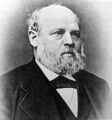Template:Selected anniversaries/May 26: Difference between revisions
Jump to navigation
Jump to search
No edit summary |
No edit summary |
||
| Line 12: | Line 12: | ||
||1865: Heinrich Biltz born ... chemist and academic. Pic. | ||1865: Heinrich Biltz born ... chemist and academic. Pic. | ||
||1874: Henri Farman born ... aviator and aircraft designer and manufacturer with his brother Maurice Farman. | ||1874: Henri Farman born ... aviator and aircraft designer and manufacturer with his brother Maurice Farman. Pic. | ||
||1885: Roland Weitzenböck born ... mathematician working on differential geometry who introduced the Weitzenböck connection. Pic. | ||1885: Roland Weitzenböck born ... mathematician working on differential geometry who introduced the Weitzenböck connection. Pic. | ||
| Line 30: | Line 30: | ||
||1902: Almon Brown Strowger dies ... inventor who gave his name to the Strowger switch, an electromechanical telephone exchange technology that his invention and patent inspired. Pic. | ||1902: Almon Brown Strowger dies ... inventor who gave his name to the Strowger switch, an electromechanical telephone exchange technology that his invention and patent inspired. Pic. | ||
||1904: Georges Gilles de la Tourette dies ... physician and neurologist. | ||1904: Georges Gilles de la Tourette dies ... physician and neurologist. Pic. | ||
||1926: Frank Nelson Cole dies ... mathematician. Pic. | ||1926: Frank Nelson Cole dies ... mathematician. Pic. | ||
| Line 44: | Line 44: | ||
||1957: Edward Hutchinson Synge dies ... physicist who published a complete theoretical description of the near-field scanning optical microscope, an instrument used in nanotechnology, several decades before it was experimentally developed. He never completed university yet did significant original research in both microscopy and telescopy. He was the first to apply the principle of scanning in imaging, which later became important in a wide range of technologies including television, radar, and scanning electron microscopy. Pic search yes: https://www.google.com/search?q=edward+hutchinson+synge | ||1957: Edward Hutchinson Synge dies ... physicist who published a complete theoretical description of the near-field scanning optical microscope, an instrument used in nanotechnology, several decades before it was experimentally developed. He never completed university yet did significant original research in both microscopy and telescopy. He was the first to apply the principle of scanning in imaging, which later became important in a wide range of technologies including television, radar, and scanning electron microscopy. Pic search yes: https://www.google.com/search?q=edward+hutchinson+synge | ||
||1969: Allan Haines Loughead dies ... engineer, co-founded the Lockheed Corporation. | ||1969: Allan Haines Loughead dies ... engineer, co-founded the Lockheed Corporation. Pic search yes: https://www.google.com/search?q=Allan+Haines+Loughead | ||
||1969: Apollo program: Apollo 10 returns to Earth after a successful eight-day test of all the components needed for the forthcoming first manned moon landing. | ||1969: Apollo program: Apollo 10 returns to Earth after a successful eight-day test of all the components needed for the forthcoming first manned moon landing. | ||
||1981: Italian Prime Minister Arnaldo Forlani and his coalition cabinet resign following a scandal over membership of the pseudo-masonic lodge P2 (Propaganda Due). | ||1981: Italian Prime Minister Arnaldo Forlani and his coalition cabinet resign following a scandal over membership of the pseudo-masonic lodge P2 (Propaganda Due). (Alive May 2019.) Pic. | ||
||1997: Manfred von Ardenne dies ... research and applied physicist and inventor. He took out approximately 600 patents in fields including electron microscopy, medical technology, nuclear technology, plasma physics, and radio and television technology. From 1928 to 1945, he directed his private research laboratory Forschungslaboratorium für Elektronenphysik. For ten years after World War II, he worked in the Soviet Union on their atomic bomb project Pic. | ||1997: Manfred von Ardenne dies ... research and applied physicist and inventor. He took out approximately 600 patents in fields including electron microscopy, medical technology, nuclear technology, plasma physics, and radio and television technology. From 1928 to 1945, he directed his private research laboratory Forschungslaboratorium für Elektronenphysik. For ten years after World War II, he worked in the Soviet Union on their atomic bomb project Pic. | ||
| Line 55: | Line 55: | ||
||1999: Waldo Semon dies ... chemist and engineer ... credited with inventing methods for making polyvinyl chloride useful. Pic. | ||1999: Waldo Semon dies ... chemist and engineer ... credited with inventing methods for making polyvinyl chloride useful. Pic. | ||
||2006: Alan Kotok dies ... computer scientist known for his work at Digital Equipment Corporation (Digital, or DEC) and at the World Wide Web Consortium (W3C). Early hacker. Pic. | ||2006: Alan Kotok dies ... computer scientist known for his work at Digital Equipment Corporation (Digital, or DEC) and at the World Wide Web Consortium (W3C). Early hacker. Pic. | ||
| Line 62: | Line 60: | ||
||2010: First flight of the Boeing X-51 Waverider: https://en.wikipedia.org/wiki/Boeing_X-51_Waverider Pic. | ||2010: First flight of the Boeing X-51 Waverider: https://en.wikipedia.org/wiki/Boeing_X-51_Waverider Pic. | ||
||2015: Robert Kraft dies ... astronomer and academic. | ||2015: Robert Kraft dies ... astronomer and academic. Kraft performed pioneering work on Cepheid variables, stellar rotation, novae, and the chemical evolution of the Milky Way. His name is also associated with the Kraft break: the abrupt change in the average rotation rate of main sequence stars around spectral type F8. Pic. | ||
</gallery> | </gallery> | ||
Revision as of 14:46, 23 May 2019
1667: Mathematician and theorist Abraham de Moivre born. His book on probability theory, The Doctrine of Chances, will be prized by gamblers.
1814: Glassblower, physicist, and inventor Johann Heinrich Wilhelm Geißler born. He will invent the Geissler tube, made of glass and used as a low pressure gas-discharge luminescence tube.
2016: New autobiography by Didacus automaton accuses Baron Zersetzung of crimes against mathematical constants.
1895: Documentary photography and photojournalist Dorothea Lange born.
1936: Enrico Fermi publishes new class of Gnomon algorithm functions which detect and prevent crimes against mathematical constants.
1938: In the United States, the House Un-American Activities Committee begins its first session.





